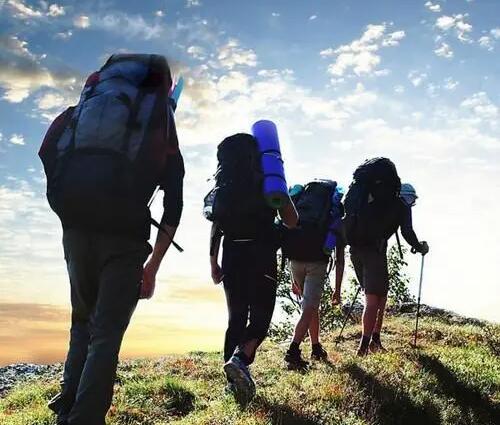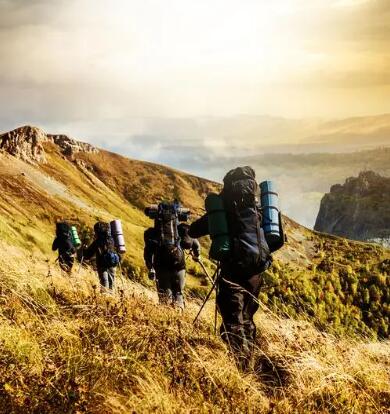Outdoor hiking personal equipment strategy_ What are the necessary supplies for outdoor hiking travel?

1. Backpack (a must for short-distance camping or long-distance travel, it is better to carry it with comfort and bearing bearing, ranging from 45-80L);
2. Small backpacks (short-distance travel or long-distance use, there is a certain burden, ranging from 15-30L);
3. Waste or shoulder bag (Put a small thing for a small thing during long -distance travel, it is best to put the kettle);
4. Photography bags (according to personal needs, cross -body is more convenient to use lens).
5. Outdoor hiking rods are used to relieve long walking and fatigue on the legs.
(2) Camping chapter
1. Sleeping bags (long -distance should be a small down sleeping bag, saving space, and it is based on the needs of the season);
2. Inner biliary of sleeping bags (if you do not camping long -distance travel, just bring a anti -dirty fleece or cotton sleeping bag inner bilots);
3. Tents (ordinary camping, general waterproof wind resistance tents are sufficient. If long -distance running, it is recommended to bring a small light tent with a small size);
4. Tent seats (protect your tent bottom, avoid wear);
5. To moisture -proof pads (ordinary ones can let you sit down and lie down anytime, anywhere, the padding pad makes you more comfortable);
6. Aluminum -membrane seats (light and convenient with lightness, it is necessary to be used as a reflective board for photography).
(3) Lighting
1. Head light (it can make your hands free up, it is very convenient);
2. Flatlight (as a backup lighting, it is still more available);
3. Camplights (use in the camp or in the tent, the effect is very good);
4. fluorescent sticks (have a certain effect, that is, do not throw random, not environmental protection);
5. Wind -proof lighter (not small use, good lighting during emergency);
6. Waterproof match (also for emergency).

If you are a newbie, we recommend.......
1. Map and compass
There are not many signs on the mountain road. Once you lose or go to the place where people can't go out, you will lose your direction and goals. Lost and disappearances are the most common reasons that causes mountain difficulties. Therefore, climbers must bring compass and maps, and must be familiar with the use of them in advance. The map will tell you where there are villages or roads, and help you find a way of life at a critical moment.
2. Head lights+spare lights and batteries
Some friends may ask why you do n’t need to use a flashlight to use headlights, because hanging the lights on your head, your hands can be empty and used in more needed places. For example, some team members may be injured. Maps and so on. Even if you are expected to take the mountain road only during the day, you have to take the headlight, because sometimes you may change the weather for sudden or the path collapse and cause night return. This is an unpredictable thing.
3. Food
Do not bring food without food to reduce the weight of the backpack. Hungry will not only lead to insufficient physical strength, but also cause dizziness due to hypoglycemia. In fact, a lot of light foods have been launched on the market, such as fast -food rice that can be eaten by cooking free of boiling or hot water. In addition, the combination of jerky, dried fruits, raisins and candy is also a good choice.
4. extra clothes
Insulation is the first important righteousness of survival in the wild. Under emergency, extra clothes can save you. In addition to hiking waterproof and windproof cold clothing, extra clothes should also be prepared to cope with ever -changing weather, such as down vests or a set of sweaty underwear. Due to the limited waterproof capacity of the backpack, the clothes should be wrapped in a waterproof bag to ensure that it is dry.
5. Emergency medical box
Equipment and medication of emergency medical boxes should be external injuries, burns, worm biting, fever, anti -inflammatory, cramp prevention and individual special needs. Although the medical behavior that can be performed in the mountains is very limited, if there is no emergency medical box, some basic trauma treatment cannot be treated immediately, which will increase the chance of bacterial infection.
6.
When you encounter an emergency, the knife can do a lot of work, such as setting up a shelter, fire, burden, or even climbing, so every climber should carry a knife with him. There are small knives and medium -sized knives commonly used on the mountains. Medium -sized knives are the best weapons for raw fire, driving diameter and self -defense, and small knives are more smooth in cooking food or processing certain events.
7. match/lighter
It is easy to buy a stove to make fire on the market. There is no need to get rid of the fire as much as ancient times. Bringing matches and lighters is for later use. In case someone is lost and lost the stove, when necessary, you can also use a lighter and fire to quickly produce a pile of fire in the wild.
8. Rainwear
It is too inconvenient to support umbrellas in the mountains, so raincoats are the best waterproofing tools. Although the weather will be selected for the weather before climbing, the weather is sometimes not 100%accurate, and raincoats are the most important tools when encountering wind and rain on the mountain.
9. Survival box
The survival box must be a metal seal box, which should be equipped with small and scattered survival supplies or repair supplies such as fine ropes, iron wires, rebuilding paper, lighters, needle wire bags, reflex mirrors, whistles, small straws, etc. When necessary, it can be used as cooking utensils.
10. Sun mirror
Mountaineering wearing sunglasses has actual needs. The strength of high -mountain ultraviolet rays above three kilometers will be more than 50 % than the sea level, let alone in the snow. Bare eyes in this situation can easily cause snow blindness, and sunglasses are used to prevent ultraviolet damage.
11. Mountaineering sticks can alleviate the burden on legs and knee joints during the long -distance and mountaineering walk!
Go to mountaineering and hikes to prepare, so as to rest assured that you can enjoy climbing.
 OUPRS Outdoor Products
OUPRS Outdoor Products